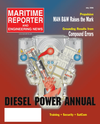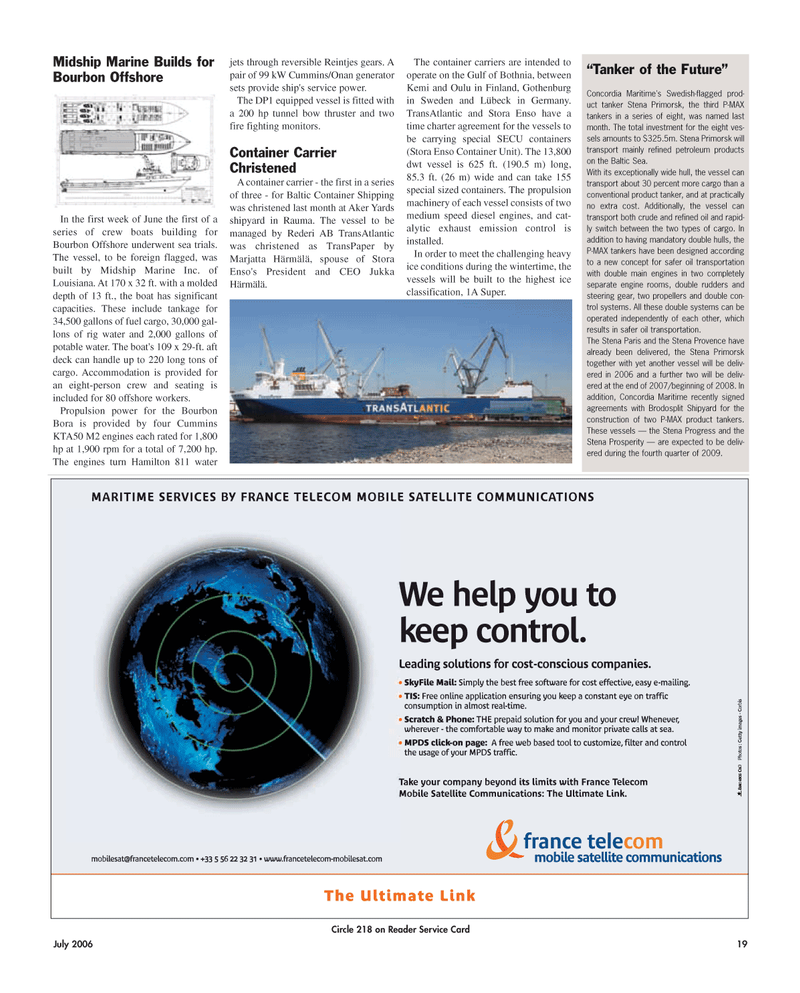
Page 19: of Maritime Reporter Magazine (July 2005)
The Satellite Communications Edition
Read this page in Pdf, Flash or Html5 edition of July 2005 Maritime Reporter Magazine
July 2006 19
Midship Marine Builds for
Bourbon Offshore
In the first week of June the first of a series of crew boats building for
Bourbon Offshore underwent sea trials.
The vessel, to be foreign flagged, was built by Midship Marine Inc. of
Louisiana. At 170 x 32 ft. with a molded depth of 13 ft., the boat has significant capacities. These include tankage for 34,500 gallons of fuel cargo, 30,000 gal- lons of rig water and 2,000 gallons of potable water. The boat's 109 x 29-ft. aft deck can handle up to 220 long tons of cargo. Accommodation is provided for an eight-person crew and seating is included for 80 offshore workers.
Propulsion power for the Bourbon
Bora is provided by four Cummins
KTA50 M2 engines each rated for 1,800 hp at 1,900 rpm for a total of 7,200 hp.
The engines turn Hamilton 811 water jets through reversible Reintjes gears. A pair of 99 kW Cummins/Onan generator sets provide ship's service power.
The DP1 equipped vessel is fitted with a 200 hp tunnel bow thruster and two fire fighting monitors.
Container Carrier
Christened
A container carrier - the first in a series of three - for Baltic Container Shipping was christened last month at Aker Yards shipyard in Rauma. The vessel to be managed by Rederi AB TransAtlantic was christened as TransPaper by
Marjatta Härmälä, spouse of Stora
Enso's President and CEO Jukka
Härmälä.
The container carriers are intended to operate on the Gulf of Bothnia, between
Kemi and Oulu in Finland, Gothenburg in Sweden and Lübeck in Germany.
TransAtlantic and Stora Enso have a time charter agreement for the vessels to be carrying special SECU containers (Stora Enso Container Unit). The 13,800 dwt vessel is 625 ft. (190.5 m) long, 85.3 ft. (26 m) wide and can take 155 special sized containers. The propulsion machinery of each vessel consists of two medium speed diesel engines, and cat- alytic exhaust emission control is installed.
In order to meet the challenging heavy ice conditions during the wintertime, the vessels will be built to the highest ice classification, 1A Super.
Circle 218 on Reader Service Card “Tanker of the Future”
Concordia Maritime's Swedish-flagged prod- uct tanker Stena Primorsk, the third P-MAX tankers in a series of eight, was named last month. The total investment for the eight ves- sels amounts to $325.5m. Stena Primorsk will transport mainly refined petroleum products on the Baltic Sea.
With its exceptionally wide hull, the vessel can transport about 30 percent more cargo than a conventional product tanker, and at practically no extra cost. Additionally, the vessel can transport both crude and refined oil and rapid- ly switch between the two types of cargo. In addition to having mandatory double hulls, the
P-MAX tankers have been designed according to a new concept for safer oil transportation with double main engines in two completely separate engine rooms, double rudders and steering gear, two propellers and double con- trol systems. All these double systems can be operated independently of each other, which results in safer oil transportation.
The Stena Paris and the Stena Provence have already been delivered, the Stena Primorsk together with yet another vessel will be deliv- ered in 2006 and a further two will be deliv- ered at the end of 2007/beginning of 2008. In addition, Concordia Maritime recently signed agreements with Brodosplit Shipyard for the construction of two P-MAX product tankers.
These vessels — the Stena Progress and the
Stena Prosperity — are expected to be deliv- ered during the fourth quarter of 2009.
MR JULY2006 #3 (17-24).qxd 7/5/2006 11:38 AM Page 19

 18
18

 20
20
